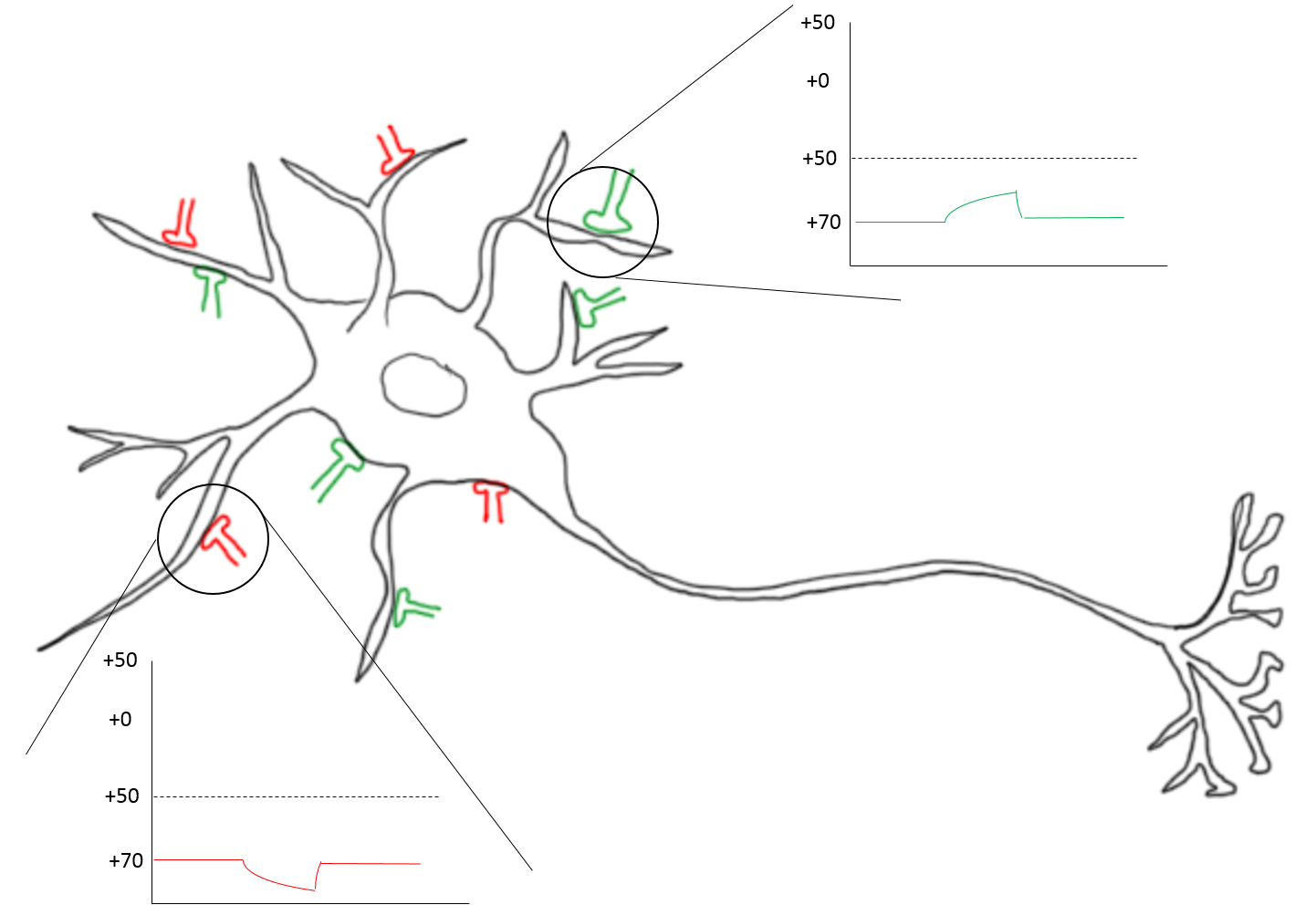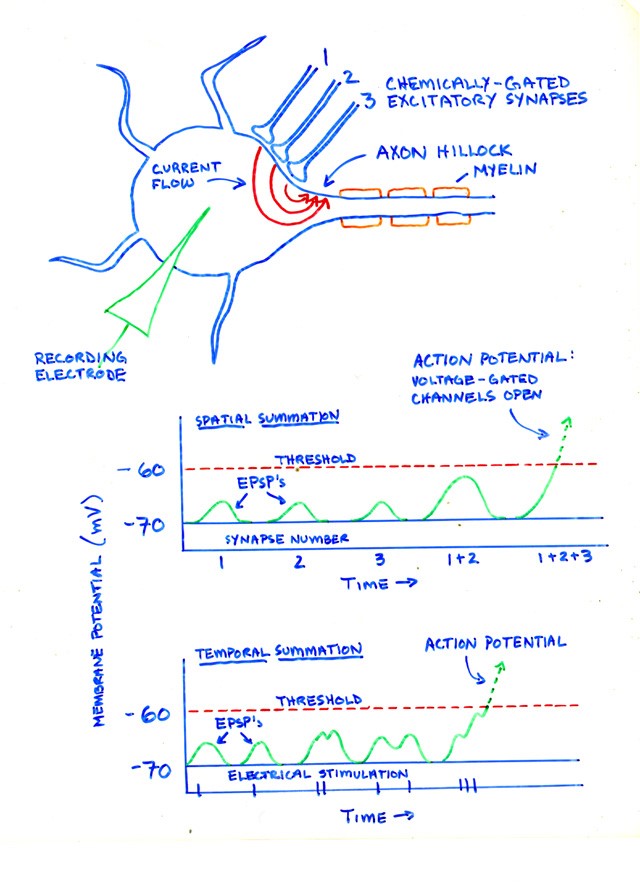INTRODUCTION TO THE NERVOUS SYSTEM
PHYSIOLOGY OF THE NEURON
Typically, voltage changes in neurons flow from dendrites, to the soma, to the axon. In sensory neurons, however, environmental stimuli (light, chemicals, pain) activate ion channels which produce action potentials that flow from the axon to the soma. In either case, neurons propagate signals along their axons in the form of action potentials, which is how neurons communicate with other neurons or cells. The communication that occurs between these cells is called synaptic transmission.
The synapse
Structurally, two types of synapses are found in neurons: chemical and electrical. Chemical synapses occur when neural membranes abut very close together, but remain distinct, leaving a space. Electrical synapses occur when membranes are linked together (gap junctions) via specialized proteins that allow the flow of ions from one cell to another. Electrical synapses are found in heart muscle. Because electrical synapses are rare in the nervous system, the remaining discussion will address the chemical synapse.
Chemical synapses use chemicals called neurotransmitters to communicate the messages between cells. The part of the synapse that releases the neurotransmitter into the synapse is called the presynaptic terminal, and the part of the synapse that receives the neurotransmitter is called the postsynaptic terminal. The narrow space between the two regions is called the synaptic cleft. Both the presynaptic and postsynaptic terminals contain the molecular machinery needed to carry out the signaling process. The presynaptic terminal contains large numbers of vesicles that are packed with neurotransmitters. When an action potential arrives at the presynaptic terminal, voltage gated Ca++channels open, which allows for the influx of Ca++ which then activates an array of molecules in the neuronal membrane and the vesicular membrane to become activated. These newly activated molecules then induce exocytosis of the vesicles, which results in release of the neurotransmitter. The neurotransmitter then binds to receptors located in the postsynaptic membrane and induces a conformational change. This conformation change causes the receptor to act as a pore in the membrane for ions to move through. Depending on the type of ion, the effect on the postsynaptic cell may be depolarizing (excitatory) or hyperpolarizing (inhibitory).

© 2013 Encyclopædia Britannica, Inc. Taken from BYUI Image Quest Dec 2013.
An excitatory response is called an EPSP which is the abbreviation for an "excitatory post synaptic potential," whereas an inhibitory response is called an IPSP or "inhibitory post synaptic potential." As the name suggests, an EPSP elicits an excitatory response, or membrane depolarization, whereas an IPSP results in an inhibitory response, or membrane hyperpolarization.

Image by JS BYU-I, 2013
.
EPSP and IPSP. A cell body will have many synapses on it and on its surrounding dendrites. Some of the synapses will result in the cell body membrane potential moving closer to threshold. Other synapses result in the cell body membrane potential moving farther from threshold (hyperpolarization). Any synapse that moves the potential closer to threshold is called an Excitatory Post Synaptic Potential, and any synapse that moves the potential farther from threshold is called an inhibitory Post Synaptic Potential. The net effect of all the EPSPs and IPSPs is experienced at the axon hillock. If threshold is reached, then an action potential will continue down the axon.
The ultimate goal of an EPSP is to cause enough change in the membrane to initiate an action potential. The goal of the IPSP is to cause a change in the membrane to prevent an action potential. Each EPSP or IPSP lasts a few milliseconds and then the membrane returns to the original resting membrane potentials. In many cases, a single EPSP is not sufficient to cause an action potential. Therefore, many EPSPs from multiple synapses can combine at the soma, which results in a much larger voltage change that can exceed threshold and cause and action potential. This phenomenon is called spatial summation. EPSPs from the same synapse can also combine if they arrive in rapid succession; this phenomenon is called temporal summation. Requiring multiple EPSPs to fire an action potential are ways that neurons increase sensitivity and accuracy.

Image by LB, BYU-I, 2013.
Summation
A response as an EPSP or an IPSP will depend on the type of neurotransmitter/receptor combination present in the synapse. There are over a hundred known neurotransmitters, and many of them have unique receptors. Receptors can be divided into two broad groups: chemically gated ion channels and second messenger systems. When chemically gated ion channels are activated, certain ions are allowed to flow across the membrane. The ion type will determine on whether the result is an EPSP or an IPSP. When a second messenger system is activated, it results in a cascade of molecular interactions within the target or postsynaptic cell. The type of cascade that is elicited will result in the response being either excitatory or inhibitory.
Excitatory Synapses
Most excitatory synapses in the brain use glutamate or aspartate as the neurotransmitter. These neurotransmitters bind to non-selective cationic channels that allow for Na+ and K+ to pass. As mentioned earlier, it takes many EPSPs from these kinds of synapses to depolarize a postsynaptic neuron enough to reach threshold and trigger an action potential.
A very important subset of synapses in the brain includes a group capable of forming memories by increasing the activity and the strength of the synapse. This process is called long-term potentiation. Long-term potentiation operates at the synapse, using the neurotransmitter glutamate and the receptor known as the NMDA receptor. The NMDA receptor is unique in that it is both ligand and voltage regulated. When activated by ligands, it becomes permeable to Na+, but if the charge difference is sufficient, the channel becomes permeable to Ca++ as well. Ca++ can initiate a second messenger cascade that results in an increase in the number of glutamate receptors, thereby increasing the strength of the synapse. The change in strength can last for weeks, months, or even years depending on whether or not the synapse is continually used.
Inhibitory Synapses
It may seem somewhat of a paradox to have inhibitory synapses, but the excitability of neurons is essentially governed by a balance between excitation and inhibition. The main inhibitory neurotransmitters are GABA and glycine. Both neurotransmitters bind to receptors that result in an increase conductance of Cl-. Because of the negative charge of Cl- and the fact that it usually moves into the cell, the effect is to oppose depolarization and cause the membrane to move away from threshold.
Modulatory synapses
Modulatory synapses are those that can be "primed" by neuromodulators so that they are able to respond more powerfully to other inputs. An example of a priming neuromodulator is norepinephrine. By itself, norepinephrine has little effect on synaptic transmission, but when a cell is exposed to norepinephrine first, it will react more powerfully to glutamate.
**You may use the buttons below to go to the next or previous reading in this Module**


